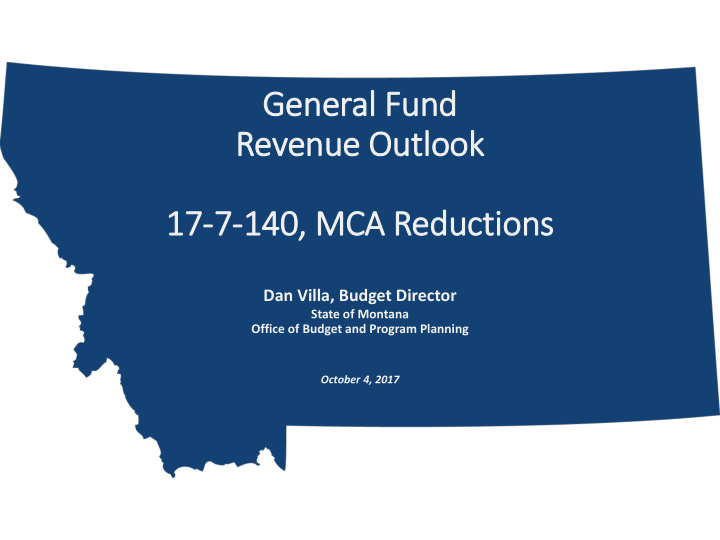



General l Fund Revenue Outlo look 17 17-7-140, MCA Reductio ions Dan Villa, Budget Director State of Montana Office of Budget and Program Planning October 4, 2017
Our Revenue Streams Do Not Reflect Our Economy As They Once Did
FY 2017 and 2019 Biennium General Fund Status (Millions $) Actual Enacted Description FY 2017 FY 2018 FY 2019 Beginning Fund Balance 256.478 47.564 (35.576) OBPP Revenue Estimate - August, 2017 2,141.479 2,233.266 2,336.240 Transfers-In (SB 261) 31.640 1.640 Prior Year Revenue Adjustments (2.111) Total Funds Available 2,395.846 2,312.470 2,302.304 General Appropriations Act HB 2 Disbursements (Adjusted for SB 261) 2,004.574 1,986.310 2,033.305 Non-HB 2 Disbursements HB 1 - Feed Bill 8.239 2.210 9.063 HB 3 - Supplemental 23.167 20.000 20.000 Non HB 2 Reductions (SB 261) (2.630) (2.630) Other Disbursements Statutory Appropriations 291.065 325.531 313.825 Transfers 20.668 20.108 20.693 Fire Fund Transfer (HB 354) 11.422 Other Appropriations 5.602 4.291 0.281 Reversions (7.774) (7.902) Prior Year Expenditure Adjustments (4.058) Total Disbursements 2,360.679 2,348.046 2,386.635 Fund Balance Adjustments 12.397 Ending Fund Balance 47.564 (35.576) (84.331) YOY Expenditure Growth -0.54% 1.64% YOY Revenue Growth 4.29% 4.61% Fund Balance as a % of Total Spend -1.52% -3.53% 143.20 "Cut-To" Target 119.33 Trigger
FY 2018 Ending Fund Balance Scenario's Based on Revenue Growth ($20 million fire cost scenario for FY 18) 9.30% 72 8.30% 50 7.30% 29 6.30% 8 Revenue Growth 5.30% -14 4.30% -35 3.30% -57 2.30% -78 1.30% -100 0.30% -121 -150 -100 -50 0 50 100
How do we reach HJ2 estimates?
How do we reach HJ2 estimates for PIT?
Natural Resource Revenues Are Beyond Our Control Montana Quarterly Oil Production 10,000 9,000 8,000 7,000 Bbls Oil (thousands) 6,000 5,000 4,000 3,000 2,000 1,000 Forecast Total MT Oil (Bbls)
Workforce Hurdles Are Higher…
The Conditions Which Correlate to 10%+ Revenue Growth Are Not Present
The Role of f This Committee 17-7-140(2)(c) The governor shall direct agencies to manage their budgets in order to reduce general fund expenditures. Prior to directing agencies to reduce spending as provided in subsection (1)(a), the governor shall direct each agency to analyze the nature of each program that receives a general fund appropriation to determine whether the program is mandatory or permissive and to analyze the impact of the proposed reduction in spending on the purpose of the program. An agency shall submit its analysis to the office of budget and program planning and shall at the same time provide a copy of the analysis to the legislative fiscal analyst. The report must be submitted in an electronic format. The office of budget and program planning shall review each agency's analysis, and the budget director shall submit to the governor a copy of the office of budget and program planning's recommendations for reductions in spending. The budget director shall provide a copy of the recommendations to the legislative fiscal analyst at the time that the recommendations are submitted to the governor and shall provide the legislative fiscal analyst with any proposed changes to the recommendations. The recommendations must be provided in an electronic format. The legislative finance committee shall meet within 20 days of the date that the proposed changes to the recommendations for reductions in spending are provided to the legislative fiscal analyst. The legislative fiscal analyst shall provide a copy of the legislative fiscal analyst's review of the proposed reductions in spending to the budget director at least 5 days before the meeting of the legislative finance committee. The committee may make recommendations concerning the proposed reductions in spending. The governor shall consider each agency's analysis and the recommendations of the office of budget and program planning and the legislative finance committee in determining the agency's reduction in spending. Reductions in spending must be designed to have the least adverse impact on the provision of services determined to be most integral to the discharge of the agency's statutory responsibilities.
Required Reductions 17-7-140 Biennial % Section Agency Name Agency No. Reduction Reduction Amount A - General Govt Commissioner of Political Practices 32020 (152,414) -10.00% Department of Administration 61010 (1,459,332) -10.00% Department of Commerce 65010 (725,503) -10.00% Department of Military Affairs 67010 (1,071,022) -8.20% Department of Revenue 58010 (9,179,870) -8.69% Governor's Office 31010 (1,290,839) -10.00% Labor and Industry 66020 (358,270) -10.00% B - DPHHS Public Health and Human Services 69010 (105,029,491) -10.00% C - Nat Resources Department of Agriculture 62010 (152,058) -10.00% Department of Environmental Quality 53010 (1,038,935) -10.00% Department of Livestock 56030 (511,416) -10.00% Dept. of Natural Resources/Conservation 57060 (2,929,085) -5.39% D - Public Safety Crime Control Division 41070 (461,916) -10.00% Department of Corrections 64010 (40,229,844) -10.00% Department of Justice 41100 (6,560,286) -9.57% Public Defender 61080 (6,471,590) -10.00% E - Education Board of Public Education 51010 (29,900) -10.00% Commissioner of Higher Education 51020 (42,810,094) -9.57% Historical Society 51170 (536,071) -10.00% Library Commission 51150 (441,836) -10.00% Montana Arts Council 51140 (105,663) -10.00% Office of Public Instruction 35010 (7,770,617) -9.57% Total Recommended Reductions (229,316,052) Average Percentage Reduction -9.571%
More Responsible Solutions fr from Our Predecessors Governor Martz • Increased tobacco tax • Increased accommodations tax • Created Medicaid provider taxes • Created rental car revenues Governor Racicot Oversaw the “99/99” Plan which lead to $99 million in cuts and $99 million in revenue enhancements*
Ig Ignoring th the Problem Will Only Make Fu Future Cuts Deeper Source: https://www.mercatus.org/publication/weathering-next-recession-how-prepared-are-50-states Source: Managing Financial Volatility, LFD, 2016
Recommend
More recommend